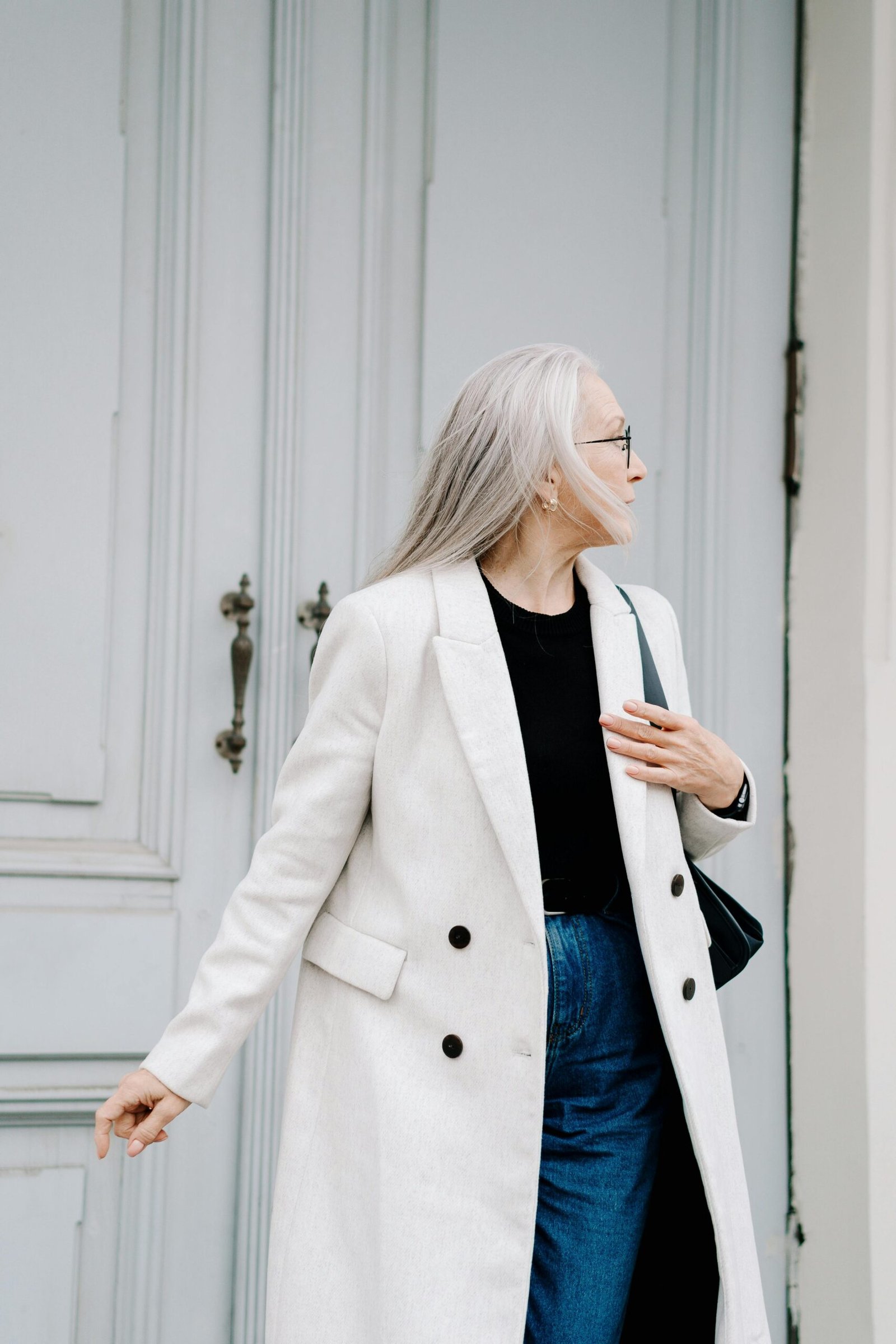Photo Credit (Pixeles)
Even in our golden years, embracing fashion helps us to express our dignity and heart, demonstrating that beauty and style have no age.
Contrary to popular assumption, age and the health issues it can bring do not have to be impediments to fashion. Fashion is a deeply individualized expression that may be both comfortable and stylish, combining elegance and ease of wear. It is quite possible to strike a healthy balance between the functional requirements of our garments and the unique style we intend to portray.
Our guide is dedicated to combining safety, style, and comfort with elegance, proving that you can look and feel attractive at the age of 65 and beyond. With the appropriate technique, aging gracefully while remaining fashionable is not only possible but also enjoyable, allowing seniors to continue expressing their unique personalities via fashion.
Comfort Comes First: Selecting the Right Fabrics and Fits
Charming elderly woman using laptop on sofa (Pexels)
The importance of choosing materials that combine comfort and ease of care cannot be stressed for seniors, as these options significantly improve their daily comfort and overall quality of life. Seniors can have a wardrobe that is not only fashionable but also ideally tailored to their needs and lifestyle by selecting materials that are kind on the skin and easy to care for.
Wool and its blends provide warmth and softness on the skin, making it an ideal choice for elders. Woolen clothing, such as socks and sweaters, are both utilitarian and luxurious due to their natural elasticity, which allows for pleasant movement.
Also, seek out thermal cotton blends that provide warmth without adding weight, assuring comfort and freedom of movement.
Silk’s moisture-wicking properties and smooth touch make it excellent for undergarments, offering breathing comfort. Silk’s exquisite drape elevates any look, transforming simple pieces like a classic shirt or a flowing midi skirt into sophisticated design statements.
Bamboo
Bamboo fabric is gaining popularity due to its silky feel and breathability, making it a sustainable alternative to pure silk. Although the research is currently inconclusive, bamboo’s possible UV protection is an excellent additional feature that combines function with eco-conscious fashion.
Cotton is still a popular fabric due to its softness, breathability, and lightweight properties. Cotton-based outfits are a practical choice for seniors because they are easy to care for, guaranteeing that style is both pleasant and convenient.
Linen
For people who appreciate cotton but want something lighter and airier, linen is an excellent choice. Linen’s unique capacity to manage moisture elevates it above a fabric to a symbol of careful, comfortable design.
Microfiber
Microfiber, known for its thermal insulation, is especially popular in milder areas, offering warmth without adding bulk. Its durability and low maintenance requirements make it an excellent choice for seniors who seek both comfort and simplicity.
When designing a wardrobe, aim to strike a balance between mobility-friendly design and aesthetic appeal. Choosing clothing that is comfortable to wear and allows for mobility while still representing their particular style can help them feel better and have more dignity. With this, fashion inspires elders to face each day with confidence and grace, demonstrating that style knows no age.
Low-Maintenance Clothing Care
Choosing low-maintenance garments and textiles for seniors streamlines their daily routines and eases the stress on caretakers.
Choose fabrics that are wrinkle and shrinkage resistant, such as polyester blends, or modal and lyocell, which are known for their strength and moisture-wicking capabilities. These fabrics can withstand repeated washing without losing form or color, making them suitable for everyday usage.
Durable, easy-care materials reduce the need for special washing or ironing, ensuring that apparel looks good with little effort.
Tips for Managing the Wardrobe
Use clear, labeled drawers or shelves for different types of clothing, and consider putting outfits together to make it easier to choose what to wear each day.
To improve freedom and ease of dressing, keep commonly used things close at hand.
Regularly examine the wardrobe to remove or replace items that no longer fit or satisfy their needs, ensuring that the selection is manageable and relevant.
Regularly reviewing the wardrobe and selecting low-maintenance apparel can considerably improve our loved ones’ comfort and autonomy in their everyday lives.
Adaptive Clothing Solutions for Easy Dressing.
Adaptive clothing is specifically developed to meet the needs of people who have mobility issues or specific medical problems, such as arthritis. This form of clothing has characteristics that make dressing easier and less unpleasant, which is especially useful for seniors who may struggle with regular garments owing to restricted flexibility or dexterity.
It could contain:
Velcro Closures and Magnetic Buttons: These replace traditional buttons and zippers, making it easier for seniors to manage their clothing without assistance and encouraging independence.
Elastic waistbands provide comfort and convenience of wear while adapting weight swings and decreasing strain on sensitive places.
Wider openings and strategic fasteners make it easier to dress and undress, as well as accommodate mobility assistance or medical gadgets.
When dressing elders with arthritis or comparable disorders, consider the following suggestions:
Layer warmly: Begin with a base layer of lightweight, warm fleece to retain body heat without adding bulk, assuring comfort and flexibility.
Choose comfortable footwear: Choose shoes with Velcro straps or slip-on designs to reduce the effort and discomfort associated with putting on and taking off shoes.
Incorporate a comfortable cardigan. Adding a warm, easy-to-remove garment, such as a cardigan, can provide additional warmth and comfort, particularly for individuals who get chilly easily.
Caregivers may assist seniors in keeping their comfort, dignity, and independence by choosing adapted clothing and following these dressing recommendations, making the everyday process of getting dressed less difficult and more fun.
Expressing Personality through Timeless Styles
Smiling Woman with Black Long Sleeve Shirt and Eyeglasses pexels
Fashion for seniors begins with creating an adaptable and easy-to-assemble wardrobe. Here are some pointers on how to put together an incredible outfit.
Accessorize to personalize.
Scarves, hats, and jewelry can instantly boost your look, giving a personal touch to any ensemble. A snug scarf or fashionable beret not only keeps you warm but also enhances your appearance, whereas exquisite jewelry can elevate a casual outfit to something exceptional for social gatherings.
Building Your Wardrobe With Basics
Every senior’s wardrobe should include basic items like comfy slacks, elastic waistband skirts, and soft, easy-to-wear tops. These fundamentals are not only comfy but also extremely flexible, providing you endless mix-and-matching options.
Seniors can easily design a number of stunning outfits utilizing a palette of complementary colors and styles. Regardless of the mix, the end effect is always a unified and attractive look, making daily dressing effortless and pleasurable while maintaining an air of sophistication.
Colorful Accents
Encouraging seniors to incorporate color into their outfits can dramatically improve their mood and allow them to show their individual identities.
Incorporating their favorite colors into everyday outfits can transform an average day into a vivid one with the simple addition of a colorful garment. Whether through clothing or accessories, adding a pop of color not only refreshes an ensemble but also improves the individual’s entire appearance.
Special clothing for special events.
A senior’s wardrobe should include a few crucial pieces for special events that combine elegance and comfort.
Invest in versatile pieces such as a classic jacket, a versatile dress, or soft, sophisticated trousers that can be dressed up with accessories or left plain for less formal occasions. These pieces should be picked for their simplicity of wear and flattering ability, so that elders feel confident and at ease at any social occasion. Yes, some pieces are expensive, but there is no substitute for a well-structured blazer and a figure-flattering dress.
Seniors who choose timeless, versatile attire can easily transition between casual and formal settings, always prepared to create an elegant impression.
Finding the Right Footwear.
When choosing footwear for the elderly, consider comfort, stability, and ease of usage. To avoid falls, shoes should have nonslip bottoms, adequate support, and a good fit. Velcro straps or slip-on styles can provide convenience and independence in dressing.
Similarly, wardrobe choices should balance style and usefulness, avoiding potential hazards such as long, loose garments that could trip them up. Choose clothing with elastic waistbands, easy-to-use fasteners, and flexible fabrics that can fit mobility aids or health gadgets, so seniors not only look nice but also feel supported in their physical needs throughout the day.
Clothing That Meets Seniors’ Physical Needs
For those with mobility issues, search for items with spacious openings and flexible fabrics that glide on smoothly, ensuring that every move is met with ease.
Adjustable features such as drawstring waists and magnetic snaps cater to individual demands, making dressing a breeze. Consider apparel that is both functional and ergonomically built, such as higher-waisted jeans for sat comfort and tops with easily accessible closures.
Layering for comfort and accessibility.
Master the art of layering with lightweight, easy-to-remove garments that keep seniors comfortable and mobile. Experiment with soft, breathable fabrics that layer easily without constraining mobility, allowing for quick temperature adjustments. Whether indoors or outside, seniors may stay comfortable and elegant throughout the day.
Safe Clothing Choices
Avoid wearing long, loose clothing that could cause trips and falls. Instead, choose well-fitting clothing that molds to your body without tightness, allowing you to move freely. This decreases the danger of accidents and ensures that they feel safe, confident, and autonomous.
Adapting to Body Changes With Style
Choose clothing that adapts to and flatters changing body shapes while focusing on comfort and flexibility, such as pieces with adjustable features and elastic fabrics. Making regular tailoring sessions and arranging modifications may guarantee that clothes continue to fit well and look fantastic while also meeting the changing demands of elders.
As seniors age from 65 to 75, their bodies may change, influencing their comfort and stylistic choices. Weight variations or changing situations may shift the emphasis from form-fitting to more relaxed, draping clothes.
These changes are natural after retirement. The wonderful aspect is that fashion adapts and evolves with each individual.
Age gracefully at 12 Oaks Communities.
If you’re having trouble planning functional yet fashionable attire for seniors, contact us to learn more.
At 12 Oaks, our compassionate professionals are committed to keeping residents safe, engaged, and connected to their families and friends while they live satisfying lives. 12 Oaks Senior Living Communities are an excellent choice for anyone looking to enjoy their second act in life.
Please contact us if you have any queries or would like to organize a personalized tour.
Looking for senior living assistance? At 12 Oaks Senior Living Communities, we’d love to learn more about your specific needs and how we might be able to assist you. Our blog is one of the vital resources we offer to help seniors live meaningful and thriving lives. Contact us today to set up a visit.

